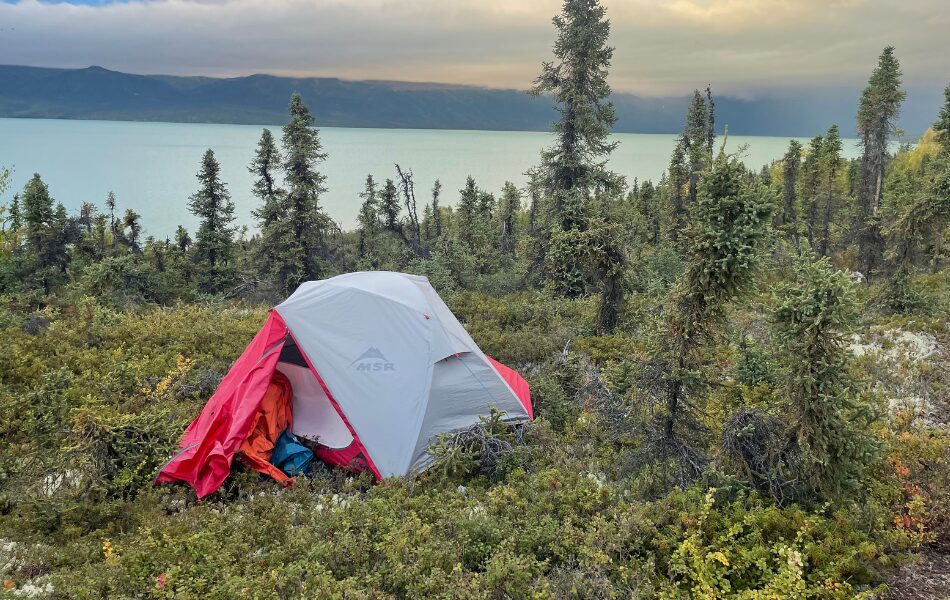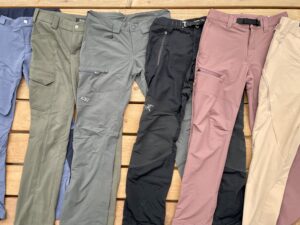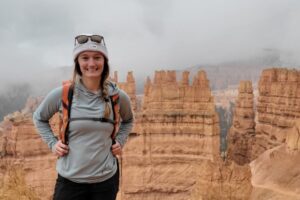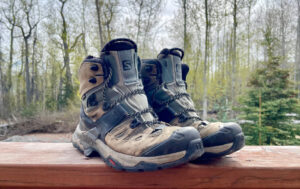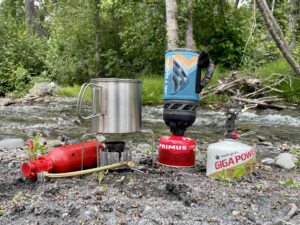A good night’s rest is vital to the success of backpacking and climbing trips. Our Gear Editor Chelsey Cook has spent nearly two decades backpacking and climbing around the world, and she’s convinced that she can suffer through just about any conditions during the day if she has a comfortable, warm place to sleep at night with a quality sleeping pad. A backpacking sleeping pad is an integral part of any sleep system. It gives the comfort you need to sleep well while also insulating you from the ground.
Gone are the days of thin foam pads or overly bulky air mattresses. The vast sleeping pad market offers everything from lightweight air pads for thru-hikers to high R-value options for winter backpackers and mountaineering to plush, self-inflating mattresses for base camping. We break down some of our favorite backpacking sleeping pads below, chosen for their comfort, durability, and packability after years of testing them in environments as far ranging as Alaska and Peru.
Editor’s Note: We updated this guide on May 25, 2024, to announce the Best Overall Backpacking Sleeping Pad as the Therm-a-Rest NeoAir XLite NXT after three years of testing. We also added superlatives for the Best Backpacking Sleeping Pad for Cold Weather, the Best Backpacking Pad for Side Sleepers, and the Best Basecamp Sleeping Pad.
The Best Backpacking Sleeping Pads of 2024
- Best Overall Backpacking Sleeping Pad: Therm-a-Rest NeoAir XLite NXT Sleeping Pad
- Best Budget Backpacking Sleeping Pad: Big Agnes Divide Insulated Sleeping Pad
- Best Backpacking Sleeping Pad for Cold Weather: Therm-a-Rest NeoAir XTherm NXT
- Best Sleeping Pad for Side Sleepers: Big Agnes Boundary Deluxe Insulated Sleeping Pad
- Best Basecamp Sleeping Pad: Exped&subId2=explorersweb MegaMat 10 Sleeping Pad
Best Overall Backpacking Sleeping Pad:
Therm-a-Rest NeoAir XLite NXT Sleeping Pad
Features: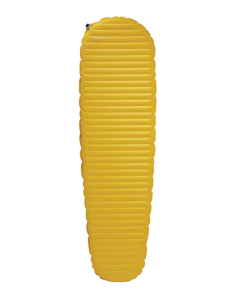
- Incredibly lightweight for a full-size pad
- WingLock™ valve for fast one-way inflation and easy micro-adjustments
- Improved internal construction for a silent sleeping pad
- Includes pump sack and field repair kit
- Packs down to the size of a Nalgene
Why we like it: Lightweight, comfortable, and incredibly durable
What we don’t like: Narrow, mummy-shape might not be for everyone
Weight: 13 oz | Thickness: 3 in | R-value: 4.5 | Type: Air | Sizes: Short, regular, large, wide
The Therm-a-Rest NeoAir XLite NXT Sleeping Pad ($209 for regular size), combines comfort with an incredibly light weight and is our overall pick for the best backpacking sleeping pad. Chelsey has been using the XLite NXT for over three years, averaging 40 to 50 days a year sleeping on it. The baffled construction keeps her back happy, and she loves how small it packs down, easily squeezing into any of her backpacks. While older versions tended to make a lot of noise when you were shifting around, Therm-a-Rest has updated its internal construction to achieve a near-silent sleeping pad.
The sleeping pad is surprisingly durable. Chelsey has yet to experience any leaks or tears in hers, despite dragging it across the Alaskan tundra and Utah’s slickrock desert for years.
Best Budget Backpacking Sleeping Pad:
Big Agnes Divide Insulated Sleeping Pad
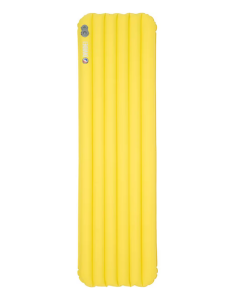
Features:
- I-Beam construction provides stability while reducing the weight
- Aviation-grade weld strength
- Thermolite® insulation with a heat-reflective film to trap body heat
- Great warranty program
Why we like it: Comfortable, packs down small, reasonably priced
What we don’t like: Not the most durable sleeping pad, heavy
Weight: 23 oz | Thickness: 3.5 in | R-value: 4 | Type: Air | Sizes: Petite, regular, long, wide, double
Ilana has been using the Big Agnes Divide Insulated Sleeping Pad ($120 for regular) on her backpacking and car camping adventures for years. It has a similar R-value and packed size as the Therm-a-Rest NeoAir XLite, however, it weighs 10 ounces more. One of the reasons for the heavier weight is the rectangular shape, which may be more comfortable than the Therm-a-Rest NeoAir XLite’s mummy shape for some people.
The Divide is made of durable, recyclable, double-ripstop nylon fabric and has aviation-grade welds. However, Ilana’s pad has sprung a few leaks over the years. Luckily, Big Agnes has an impeccable warranty program and has fixed and replaced the pads for her.
At $120, it’s significantly less than many other sleeping pads in this guide, making it a great budget buy for new backpackers. There’s also an uninsulated version of the Big Agnes Divide (R-value 1.5) for only $90.
Check Price of the Divide Insulated at REI
Check Price of the Divide Uninsulated at Amazon
Best Backpacking Sleeping Pad for Cold Weather:
Therm-a-Rest NeoAir XTherm NXT
Features: 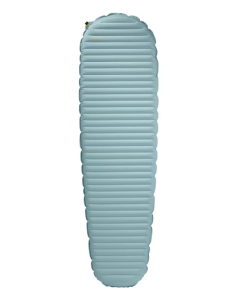
- One of the highest R-values on the market
- Current model is 2.3 ounces lighter than the previous
- Durable, with 70D nylon on the bottom and 30D ripstop nylon on the top
- WingLock™ valve for fast, one-way inflation and easy micro-adjustments for comfort
- Comes with a pump sack and field repair kit
Why we like it: Incredibly warm without sacrificing weight
What we don’t like: Expensive, shape may be narrow for some bodies, particularly when coupled with a high-loft sleeping bag
Weight: 20 oz | Thickness: 3 in | R-value: 7.3 | Type: Air | Sizes: Regular, large, wide
Chelsey has been using the Therm-a-Rest NeoAir XTherm NXT Sleeping Pad ($239) as her sleeping pad for six seasons of Denali and Alaska Range guiding. With an R-value of 7.3, it’s one of the warmest sleeping pads on the market. Coupled with a foam pad underneath, it makes the perfect sleep system for camping in the snow. Chelsey loves how lightweight and packable the sleeping pad is. It packs down to about the size of a Nalgene, making it easy to squeeze into already heavy mountaineering packs. The one-way valve and pump sack also make it easy to inflate and help saves her lungs at high altitudes.
Best Sleeping Pad for Side Sleepers:
Big Agnes Boundary Deluxe Insulated Sleeping Pad
Features: 
- Great for larger backpackers, comes in extra wide long
- Rectangular shape with bumpers means you won’t roll off
- Comfortable for side sleepers
- Soft, quilted top and durable, ripstop nylon bottom
Why we like it: Durable and comfortable, cradles you while you sleep
What we don’t like: Large rectangular footprint may not fit well in smaller tents, heavy
Weight: 25 oz | Thickness: 3.5 in | R-value: 4.3 | Type: Air | Sizes: Regular, long, wide, extra-wide
The Big Agnes Boundary Deluxe Insulated Sleeping Pad ($179 for regular) has a smooth, stable sleeping surface that is great for side sleepers. Our tester, Tanner, spent a month sleeping on the Deluxe in Southern California and liked how the inflatable bumpers kept him from rolling off the mat. He was also impressed with its durability; after a month of sleeping on loose gravel, his mat still held air. Big Agnes also offers wide and extra-wide sizes for larger-bodied backpackers. Tanner appreciated the extra room of the wide mat for his broad shoulders.
Best Basecamp Sleeping Pad:
Exped Megamat 10 Insulated Self-Inflating Sleeping Pad
Features: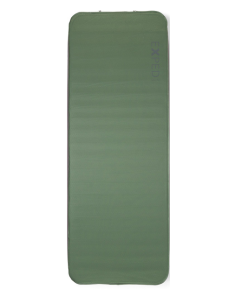
- Incredibly comfortable, with 4 inches of cushion
- Self-inflating for easy set-up, mini-pump included
- 3D construction for the largest possible sleeping surface
- Horizontal air chambers to reduce weight and packing size
- High R-value, suitable for four-season use
- Soft-stretch polyester surface for comfort
Why we like it: Self-inflating and incredibly comfortable
What we don’t like: Expensive, heavy, can take a long time to inflate
Weight: 73 oz | Thickness: 4 in | R-value: 8.1 | Type: Open-cell foam | Sizes: Regular, long, wide, extra-wide
If you’re looking for the best basecamp sleeping pad, look no further than the Exped&subId2=explorersweb Megamat 10 Insulated Self-Inflating Sleeping Pad ($240). This self-inflating mattress combines memory foam padding with air to create one of the most comfortable sleeping pads on the market. While the Megamat is too heavy and bulky to carry backpacking, Chelsey uses it for basecamp climbing and skiing trips, as well as car camping. The 4 inches of cushion are plush, and the stretch top fabric is soft and comfortable, with no crinkly sounds if you move around while you sleep. The high R-value makes it a great option for camping in the snow or on-glacier. Exped claims it’s suitable for winter camping down to -54°F, but take that with a grain of salt. Testers have found that below about -25˚F, the plastic inflation valve becomes extremely rigid and almost impossible to remove/re-engage. It’s not just Exped; all large-valve mats have that issue at extreme temperatures.
It also has a double version, the Exped MegaMat Duo 10 Sleeping Pad. Chelsey has used this version on longer trips and loves how it covers almost the entire floor of smaller tents.
About our testing process
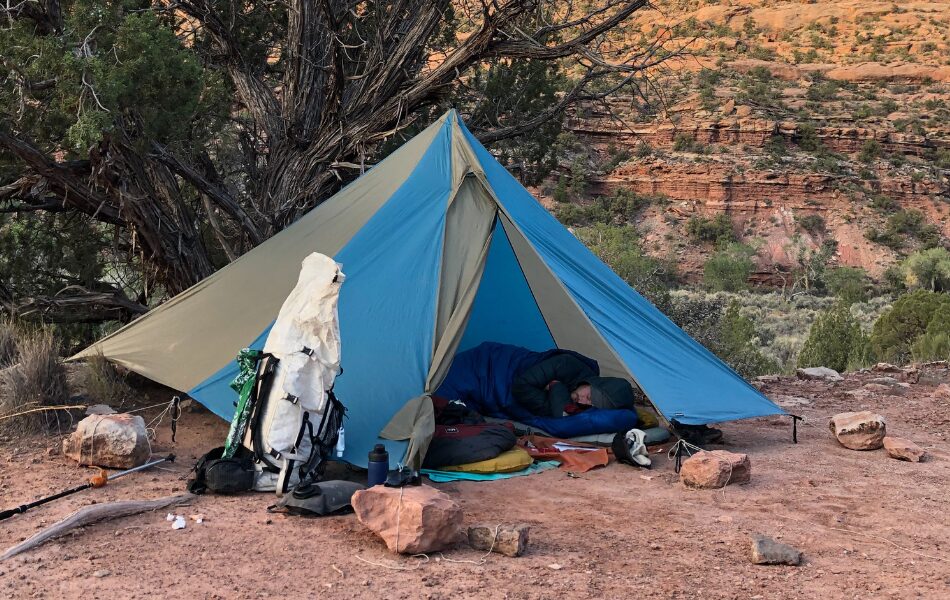
Testing backpacking sleeping pads in the Utah desert. Photo: Chelsey Cook.
The ExplorersWeb gear team is full of hardcore backpackers and climbers. We’ve spent untold hours horizontal in tents, and have inflated and deflated more styles of sleeping pads than they can count. We’ve tested sleeping pads at 17,000 feet on Denali, as well as while backpacking in the Cascades of Washington, the canyons of Utah, the mountains of Peru, and everywhere in between.
Ilana Newman started this guide in October 2022. She’s a finicky sleeper who works as a guide and outdoor educator, so she spends upwards of half the year camping out. She values comfortable sleeping pads to ensure she’s well-rested. She’s tried everything from ultralight sleeping pads to air mattresses and memory foam pads, and likes sleeping pads that provide a stable, soft surface that she can move around on.
Gear Editor Chelsey Cook took over this guide in May 2024. She has over fifteen years of experience backpacking and mountaineering. As a professional mountain guide in Alaska, Washington, and Peru, she spends more time than is probably healthy sleeping in tents. She prioritizes sleeping pads with a high R-value that are lightweight and durable enough to get her through multiple seasons.
She’s tried the majority of the sleeping pads in this guide, using them while guiding on Denali and in the Alaska Range, bringing them on canyoneering trips in Utah, and sleeping on them in the Alaskan Arctic. She led the charge on testing backpacking pads for cold weather and side-sleepers, and our pick for the best overall backpacking sleeping pad is the very same pad she’s basically been living on for the past three years.
We chose a range of backpacking sleeping pads for our guide, prioritizing weight, packability, durability, and comfort. We tested sleeping pads for winter use, side sleepers, and base camping.
Types of backpacking sleeping pads
Closed-cell foam pads
Anyone who’s ever camped on a budget probably recognizes closed-cell foam pads. They’re made from highly dense foam with tiny air cells for extra cushion. Modern closed-cell foam mattresses may also have ridges and patterns to provide more comfort and some versions will come with a layer of reflective insulation for colder climates.
They’re cheap and warm, but not that comfortable. Chelsey uses them under her Therm-a-Rest NeoAir XTherm NXT Sleeping Pad to boost warmth while winter camping.
Air pads
Air pads are the lightest and most compact choice for backpacking sleeping pads. When deflated, they simply roll up and get stashed in a stuff sack. They’re lightweight and comfortable but can be expensive and are also the most vulnerable to punctures and leaky valves. Most brands include a field repair kit with their air pads.
Self-inflating pads
Self-inflating pads are often combined with open-cell foam to increase durability and decrease the chance of punctures. While the self-inflation is a nice touch, these pads are generally heavier and less packable than true air pads.
Features to look for in backpacking sleeping pads
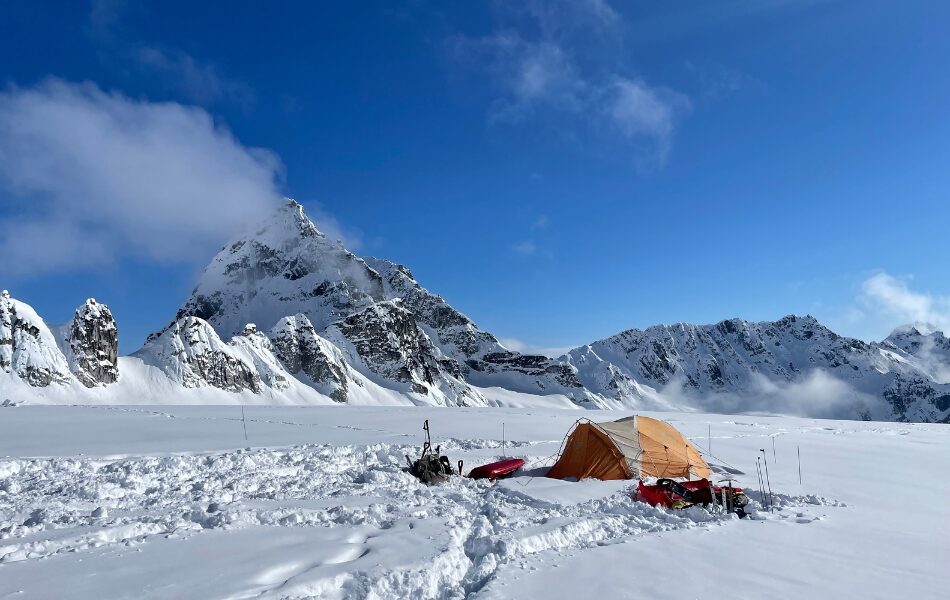
Camping in the snow or on a glacier requires a sleeping pad with a high R-value. Photo: Chelsey Cook.
Size and shape
Most sleeping pad brands offer a variety of different sizes, from short to long, wide to extra wide. While most people can use the standard, regular-sized sleeping pads, being able to choose from a variety of sizes can help you save weight by downsizing to a short pad if you are a smaller person, or choosing a wider pad so you can sleep more comfortably if you are larger-bodied.
Backpacking sleeping pads typically come in two shapes: mummy or rectangular. Mummy sleeping pads are tapered, reducing the space the pad takes up in the tent. They are typically the lightest and most packable option, though the smaller sleeping surface may not work for everyone. Rectangular sleeping pads have a greater sleeping surface for additional comfort, but also take up more room both in your tent and in your backpack.
Inflation and deflation
Foam pads don’t require inflation, but all other pads have an integrated air valve for inflation and relation. Most backpacking sleeping pads also come with one-way valves, making them easier to inflate and deflate. Some also come with inflation bags that you screw into the valve to inflate the mattress, rather than blowing the mattress up with your own lungs. These can be a great option, especially at high altitudes where you might be struggling to breathe already.
Some backpacking sleeping pads. are self-inflating, and are designed to fill up on their own. However, they usually need some extra, manual inflation to get them firm, and are generally heavier than other sleeping pads.
Weight and packability
Since you’ll be carrying your backpacking sleeping pad, a general rule of thumb is the lighter the better. However, keep in mind that ultralight pads tend to not be as durable as mid-weight pads. Backpacking sleeping pads that balance lightweight and durability generally weigh between 12 and 25 ounces.
You should also consider what size your sleeping pad packs down to. Air pads, like the Therm-a-Rest NeoAir XLite NXT Sleeping Pad pack down as small as a Nalgene bottle. Foam and self-inflating pads, on the other hand, can be bulky, and may not fit well in every backpack.
Comfort
Without a decent night’s sleep, you’ll struggle to wake up in the morning, feel drained, and may even suffer from soreness, aches, or pains. If comfort is a priority for you, look for a backpacking sleeping pad that is at least 3 inches thick and has a soft sleeping surface. Some sleeping pads can also be really noisy when you move around, so if you’re a light sleeper, go for a quieter model like the Therm-a-Rest NeoAir XLite NXT Sleeping Pad.
R-value
The R-value of a sleeping pad is the amount of insulation the pad offers between you and the ground, which directly affects the warmth of the sleeping pad. The higher the R-value, the warmer the sleeping pad. An R-value below 3 is suitable only for summer camping, while an R-value between 3 and 5 is good for three-season camping. For winter camping, you’ll want a pad with an R-value of at least 5. We prefer something with an R-value closer to 7 or 8 for winter camping, like Therm-a-Rest NeoAir XTherm NXT Sleeping Pad.
Frequently asked questions about backpacking sleeping pads
What is the most comfortable backpacking sleeping pad?
Everyone has different comfort preferences when it comes to backpacking sleeping pads, depending on their bodies and what positions they sleep in. The most comfortable pad for you is the one that lets you get the best night’s rest. If you can, test out different pads before making your purchase.
How heavy should your backpacking sleeping pad be?
Since you’ll be carrying your backpacking sleeping pad, you want to choose one that is as light as possible without sacrificing too much comfort. Three-season pads are lighter than insulated four-season pads, but any sleeping pad between 10 and 25 ounces is suitable for backpacking.
How thick should your sleeping pad be?
The standard-sized backpacking sleeping pad is around three inches thick, whereas some car camping air mattresses can be eight or nine inches thick. If you’re looking for something lightweight and packable, you may need to sacrifice thickness. But if you’re only looking for comfort and don’t mind the added weight, go as thick as you want, as long as it still fits in your backpack.
What is the best sleeping pad for side sleepers?
The best backpacking sleeping pad for side sleepers that we’ve tested is the Big Agnes Boundary Deluxe Insulated Sleeping Pad It has a smooth, stable sleeping surface and inflatable bumpers to keep you from rolling off.
